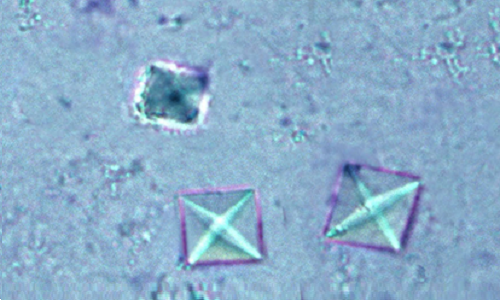Practice Scenario

Meet TIGGER
A 10-year-old, neutered male Domestic Shorthair cat
- Tigger, a mostly indoor cat, is presented for evaluation of inappropriate urination that started possibly 2 days ago. The owner reports the cat normally urinates in one of two litter boxes but recently found he had urinated in a laundry basket of dirty clothes. The owner also had noticed more urine clumps in the litter boxes and had seen Tigger drinking from his water bowl more often.
- Tigger has ad libitum access to controlled amounts of dry kibble and is offered wet food twice daily. The owner noted that he has become more finicky about which foods he will eat and has vomited occasionally in the past month.
- Physical exam revealed a bright, alert, and responsive cat with a body condition score of 5/9 and normal muscle mass. Abdominal palpation revealed a small left kidney (the right kidney could not be palpated) and a mildly distended bladder that was not painful. The rest of Tigger’s exam was unremarkable.
- Initial evaluation of urine obtained via cystocentesis showed a urine specific gravity of 1.025, no proteinuria, quiet sediment and a pH of 6.4. Other results were within normal limits. Blood work (i.e., complete blood count, serum chemistry profile, total thyroxine) results were within normal limits, although the total thyroxine level was at the upper limit of the reference range.
Lower Urinary Tract Health
Feline Lower Urinary Tract Health: The Role of Diet
Maintenance of urinary tract health is important in cats. Studies report that between 3-5% of cats presented to veterinary clinics have feline lower urinary tract diseases (FLUTDs). FLUTDs are a group of diseases, including idiopathic cystitis, urolithiasis (urinary crystals and stones), and others, which affect the bladder and urethra. FLUTDs have many contributing factors, including stress, low water consumption, excess body weight, low levels of exercise, and confinement, and are prone to recur. Nutrition can be part of a multimodal strategy to maintain urinary tract health in cats.

Key Messages
- Healthy cats may benefit from eating a food formulated to help maintain urinary tract health by supporting a balanced urinary pH.
- Access to fresh, clean water should be ensured by cleaning water bowls and refreshing the water regularly. In multi-pet households, placement of water bowls should be avoided where cats may feel at risk of being attacked by another pet, e.g., in corners of rooms.
- Most healthy cats will consume sufficient quantities of water to maintain optimal hydration when eating solely dry foods and drinking water free-choice. However, if a cat is prone to lower urinary tract issues, it may be helpful to increase water intake by:
- Feeding wet diets or adding water to dry food.
- Providing different water sources (still water, moving water, e.g., a fountain) and using different containers (avoiding plastic) in case the pet has an individual preference.
- Providing a specially-formulated, nutrient-enriched, flavored water supplement.
- Resources that reduce stress and associated risk factors for FLUTDs should be provided, such as:
- Activity with toys and play sessions, including providing food in puzzle feeders, which can also help maintain ideal body condition and, possibly, decrease other risk factors.
- An adequate number of resources (e.g., food and water bowls, clean litter boxes, toys, space) in multi-pet households and easily accessible resources (e.g., a senior cat can comfortably climb into and out of the litter box).
To Share With Pet Owner:
Evaluating Your Cat’s Body Condition
Assess your cat's Body Condition in just 3 simple steps.
Additional Resources
Lulich, J. P., Berent, A. C., Adams, L. G., Westropp, J. L., Bartges, J. W., & Osborne, C. A. (2016). ACVIM small animal consensus recommendations on the treatment and prevention of uroliths in dogs and cats. Journal of Veterinary Internal Medicine, 30(5), 1564–1574. doi: 10.1111/jvim.14559
Queau, Y. (2019). Nutritional management of urolithiasis. Veterinary Clinics of North America: Small Animal Practice, 49, 175–186. doi: 10.1016/j.cvsm.2018.10.004
Sparkes, A. (2018). Understanding feline idiopathic cystitis. Vet Record, 182(17), 486. doi: 10.1136/vr.k1848
Hostutler, R. A., Chew, D. J., & DiBartola, S. P. (2005). Recent concepts in feline lower urinary tract disease. Veterinary Clinics of North America: Small Animal Practice, 35(1), 147–170, vii. doi: 10.1016/j.cvsm/2004.08.006
Tarttelin, M. F. (1987). Feline struvite urolithiasis: Factors affecting urine pH may be more important than magnesium levels in food. Veterinary Record, 121, 227.
